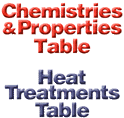
(AISI A11)
The exceptional wear resistance and good toughness of CPM 10V make it an excellent candidate to replace carbide and other highly wear resistant materials in cold work tooling applications, particularly where tool toughness is a problem or where cost effectiveness can be demonstrated.
| Typical Chemistry | |
| Carbon | 2.45% |
| Manganese | 0.50% |
| Silicon | 0.90% |
| Chromium | 5.25% |
| Vanadium | 9.75% |
| Molybdenum | 1.30% |
| Sulfur | 0.07% |
| Typical Applications | ||
| Punches & Dies for Blanking, Piercing, | ||
| Forming and Cold Extrusion | ||
| Knives for Slitting, Shearing, Trimming, etc. | ||
| Granulator/Pelletizer Blades | ||
| Nozzles, Screw Tips, Barrel Liners, etc. for | ||
| Plastic Injection Molding Equipment | ||
| Powder Compaction Tooling | ||
| Woodworking Tools | Wear Parts | |
- Annealed Hardness: BHN 255/277.
Machinability in the annealed condition is similar to D2 or M2. SG type alumina wheels or CBN wheels are recommended for the best grinding performance with the CPM steels.
Thermal Treatments
Critical Temperature: 1540F(838C).
Forging: 2000-2100F(1095-1150C) Do not forge below 1700F(930C). Slow cool after forging.
Annealing: 1600F(870C), hold 2 hours, slow cool 30F(15C)/ hr max. to 1000F(540C), then air or furnace cool. Hardness BHN 255/277. Stress Relieving (After machining): 1100-1300F(595-740C), hold 2 hrs. and air or furnace cool.
Straightening: Best done warm 400-800F(200-430C).
Hardening: (Salt, vacuum or atmosphere)
Preheat: 1500-1550F(820-845C), equalize. Second preheat stage at 1850-1900F(1010-1040C) suggested for vacuum or atmosphere hardening.
High Heat: 1850-2150F(1010-1175C). Standard recommendation to achieve Rc 60-62 after tempering is to use 2050F(1120C).
Quench: Salt, oil or atmosphere quench to 1000-1100F(540-595C), equalize, then air cool to below 125F(50C) or hand warm. Vacuum or atmosphere quench rate through 1850-1300F(1010-705C) range is critical to achieve optimum heat treat results.
Temper: 1000F(540C) minimum recommended. Double tempering is required.
| Hardening Data |
|||||||
|
|
|||||||
|
|
|
||||||
|
|
|
|
|
|
|
|
|
|
|
|
|
|
|
|
|
|
|
|
|||||||
|
|
|
|
|
|
|
|
|
|
|
|
|
|
|
|
|
|
|
|
|||||||
|
|
|
|
|
|
|
|
|
|
|
|
|
|
|
|
|
|
|
|
|
|
|
|
|
|
|
|
|
|
|
|
|
|
|
|
|
|
|
|
|
|
|
|
|
|
|
|||||||
|
NOTE A:
|
RESULTS MAY VARY WITH HARDENING METHOD AND SECTION SIZE. SALT OR OIL QUENCHING WILL GIVE MAXIMUM RESPONSE. VACUUM OR ATMOSPHERE COOLING MAY RESULT IN UP TO 1-2 HRC POINTS LOWER. | ||||||
| MINIMUM TIME AT AUST TEMP (MINS) |
|
|
|
|
|
|
|
| MINIMUM NUMBER OF TEMPERS (2 HRS) |
|
|
|
|
|
|
|
| Size Change During Hardening | |||||
|
|
|||||
|
|
|
|
||
|
|
|
|
|
||
|
|
|||||
|
|
|
|
|
|
|
|
|
|
|
|
|
|
|
|
|||||

CPM 10V can be nitrided, steam tempered or titanium-nitride coated if desired. If the CVD TiN treatment is used, care is required in vacuum hardening.
Physical Properties
Modulus of Elasticity ...................................................................32 psi x 106 (221 GPa)
Specific gravity ............................................................................................................7.41
Density .......................................................................................0.268 lb/in3 (7418 kg/m3)
Coefficient of Thermal Expansion
|
|
||
|
|
|
|
|
|
|
|
|
|
|
|
|
|
|
|
|
|
|
|
|
|
|
|
|